To Build or Not to Build?
Architects struggle with the future of their craft in a warming world
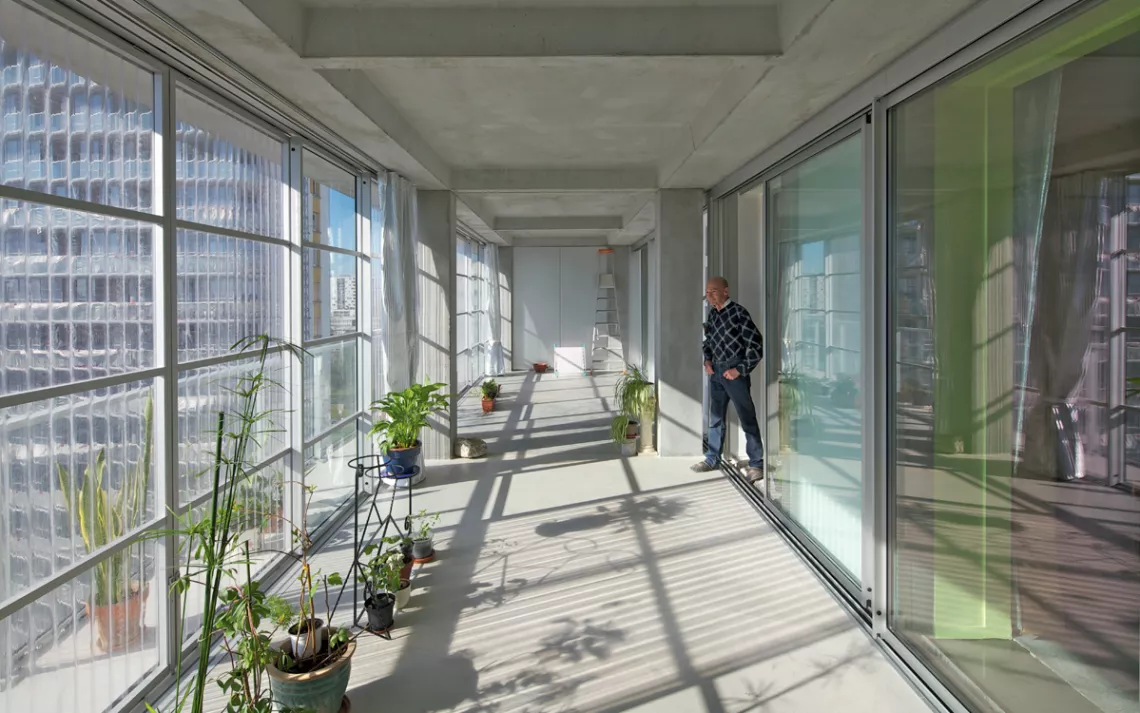
The Cité du Grand Parc housing complex in Bordeaux, France. | Photo by Philippe Ruault
THE ARCHITECTURE COMMUNITY gives itself a lot of awards, and the biggest of all is the Pritzker Prize. This "Nobel for designers," established in 1979 by the founders of the Hyatt Hotels Corporation, rewards an architect with $100,000 for "significant contributions to humanity and the built environment through the art of architecture." Each spring, the announcement of the Pritzker Laureate is highly anticipated because of what it signals about the state of the profession. In the past, critics complained that the prize was given mostly to white men, typically one solo male—as if buildings are designed by a lone genius rather than a team. The Pritzker jury has also been criticized for privileging so-called starchitecture—formally expressive buildings by brand-name architects that appear showy for the sake of it (a gift to the ego, perhaps, rather than humanity?). In recent years, the jury has awarded the prize to more women and some people of color, to duos and trios, and to architects with a social purpose or a modest design language.
However, one thing has remained the same: The Pritzker has rewarded the design of innovative new buildings. So in 2021, when the Pritzker jury picked Anne Lacaton and Jean-Philippe Vassal, a ripple went through the architecture world. The prize went to architects who essentially build nothing.
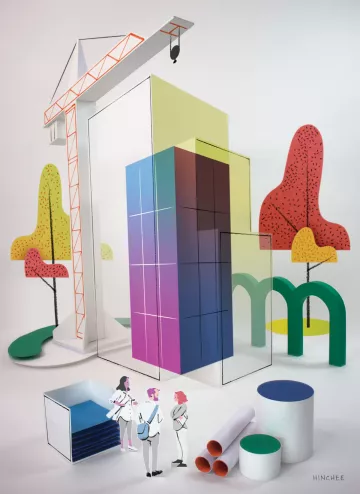
Lacaton and Vassal, partners in life and in work, are based in Paris. Since 1987, they have devoted their careers to creating better housing and civic spaces, largely through building as little as possible and instead adding square footage, more natural light, and visual verve to existing buildings. "We say, instead of demolishing, we should work with what already exists," Vassal told me. This philosophy was inspired by the pair's early years working in Niger, in West Africa, where they observed how people created simple structures, barely making an impression on the land.
Unlike preservationists, who generally focus on restoring beloved old buildings, Lacaton and Vassal also retrofit the duds. They focus on bringing new life to a building type that many enjoy seeing torn down: the grim-looking public-housing blocks of the postwar years, exemplified in the United States by the Cabrini-Green in Chicago and the Pruitt-Igoe towers in St. Louis, both famously detonated into oblivion. In 2011, the couple adapted the 16-story Tour Bois-le-Prêtre in Paris, formerly nicknamed Alcatraz. Working with Frédéric Druot Architecture, they plugged prefabricated extensions onto each of the 96 units, opening the once-dark interiors into outer layers of space: winter gardens and open balconies. Lacaton and Vassal cut energy costs by 60 percent, and the project cost only $15 million, compared with the estimated $26 million it would have cost for demolition and rebuilding. At the vast Cité du Grand Parc housing estate in Bordeaux, France, they deployed a similar approach in collaboration with Frédéric Druot and Christophe Hutin, transforming three buildings that range from 10 to 15 stories high and contain 530 affordable housing units.
"We're recycling Coke cans; we're recycling beer bottles. Why are we tearing viable buildings down in the name of progress? The greenest building is one that is already built."
There are social reasons for keeping these structures, the designers argue: People living in them have built a web of human connections over several decades that should not be swept away. "People create a sort of inside richness that nobody looks at from outside," Vassal says. Plus, he adds, there is another imperative: conserving resources. "Sustainability is to make things already existing last longer." Demolition, Lacaton has said, is "a waste of energy, of materials, a waste of history. For us, it is an act of violence."
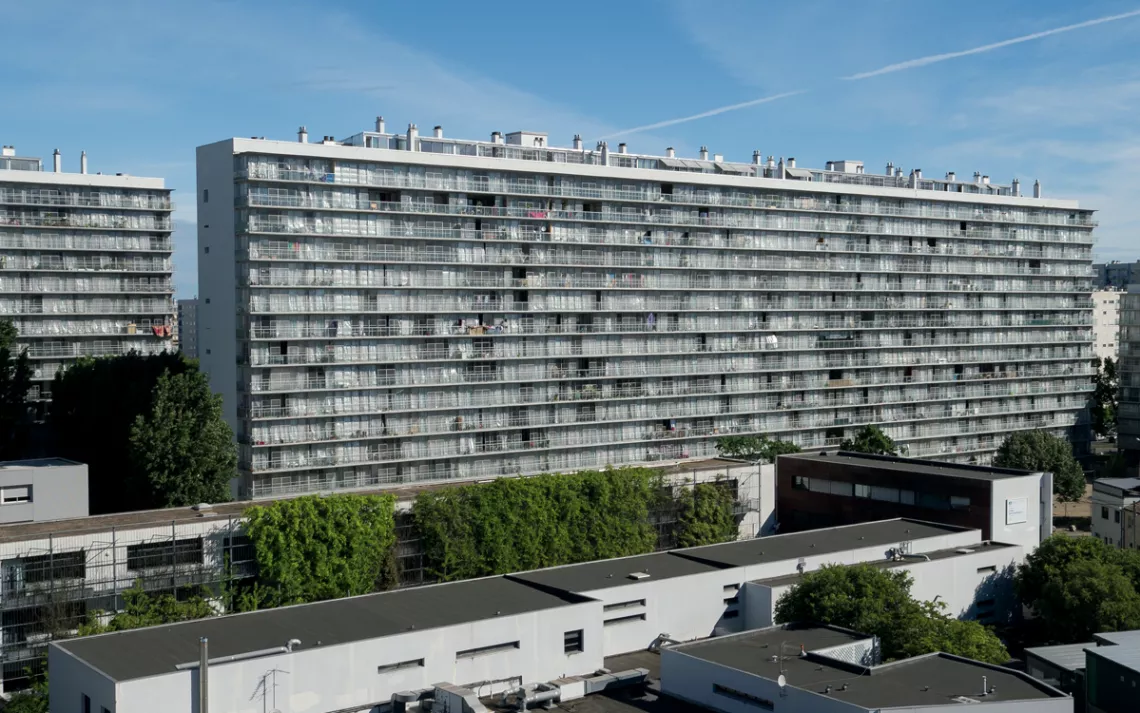
The complex was built in the 1960s and later remodeled by Anne Lacaton and Jean-Philippe Vassal, saving the buildings from demolition (shown here after adaptive reuse). | Photo by Philippe Ruault
Lacaton and Vassal have stepped into the middle of the thorniest problem facing the construction industry—what to do about its carbon footprint. They are offering an approach that is surprisingly radical but garnering growing support: Build as little as possible and use what's already there.
IN RECENT YEARS, designers, policymakers, and planners have come to realize that the built environment—mostly buildings in cities—is a colossal climate challenge. According to a declaration released in November 2020 by C40, a network of the world's megacities committed to addressing climate change, the construction sector produces almost a quarter of global greenhouse gas emissions in the form of operational and embodied carbon. Operational refers to the energy involved in running and maintaining a building, including turning on the lights, heating, ventilation, air conditioning, and moving people in elevators. Embodied refers to the carbon expended in the extraction, production, and transportation of materials and the fabrication and demolition of structures. The production of cement alone accounts for 8 percent of global greenhouse gas emissions. Diesel-powered machinery—excavators, backhoes, boom loaders—and heavy-duty vehicles servicing construction sites spew emissions along with air pollutants.

That's not all. The mining of raw materials damages ecosystems. The ceaseless spread of structures creates a heat-island effect, sending urban temperatures rising. Untrammeled construction destroys wild habitats and puts humans at risk. The deadly inundation in Rhineland, Germany, last summer resulted in part from flash flooding attributed to climate change but also from the years of building so close to riverbanks that four-fifths of the natural floodplains have been destroyed. On the West Coast of the United States, intensifying wildfires have been caused partly by a hotter climate but also by encroachment on the wildland-urban interface. A quarter of California's population now live in areas known to be fire zones, and the building industry—through its influence over local zoning laws—has been an enabler of the forest-sprawl.
"Efforts to limit rebuilding in most high-risk areas have been defeated by the construction industry and local officials," wrote Miriam Pawel in a July 2021 New York Times op-ed, "California Wakes Up From Its Dream." "Rather than offer incentives to relocate to safer ground, the state has done the reverse—encouraged rebuilding with financial help to retrofit, create defensible space, and develop evacuation plans."
"We have lost our connection to nature," Carl Elefante, a former president of the American Institute of Architects, told me. He has spent three decades working on the preservation and retrofitting of old buildings, from main-street revitalization projects to the Lincoln Memorial. "If we were more connected to the earth, we would see the consequences of our behaviors; we would see what we're doing with fossil fuels, and we wouldn't do it. We are literally fouling our nest."
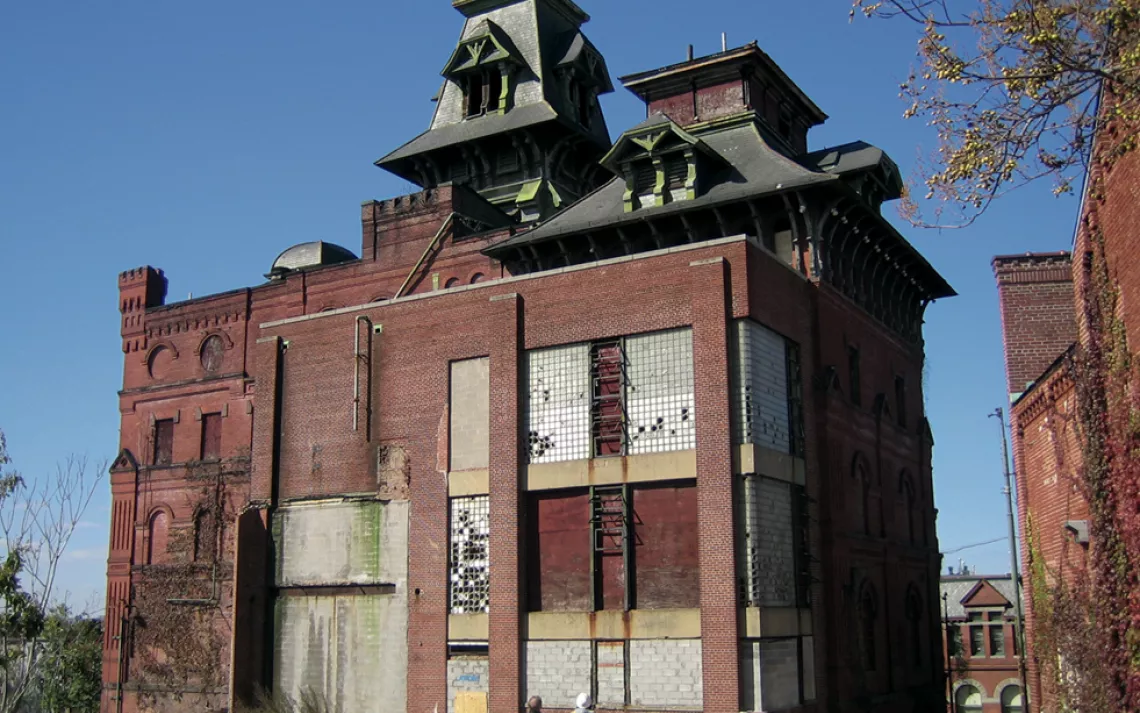
The American Brewery in Baltimore sat abandoned for decades. | Photo by Quinn Evans
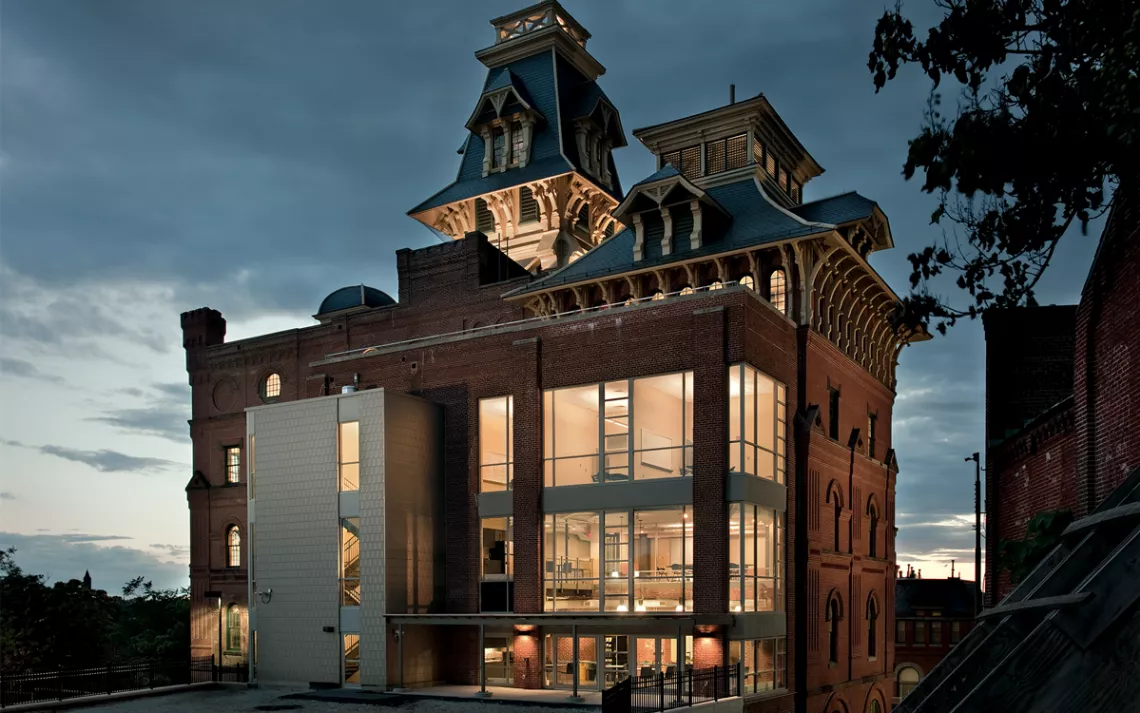
In 2009, the building was rehabbed for the nonprofit Humanim. | Photo by Paul Burk
Just how to clean up our nest, however, is the rub: Build new structures more sustainably? Or build next to nothing at all?
For the past couple of decades, "green" new building has been touted as a way to shrink the environmental footprint of construction. The newly opened net-zero-energy, zero-waste City Hall East in Santa Monica, designed by the architecture firm Frederick Fisher and Partners with Buro Happold engineers, is a shining example of a new structure designed to minimize the consumption of resources. This extension to the existing city hall is powered by solar energy, and water is sourced from an on-site well and from a gray-water treatment plant in the basement. Glass walls allow for maximum natural light, but the surfaces have been treated to protect against heat gain. The building is made from nontoxic materials, is located near mass transit, and has bicycle storage and electric-vehicle charging stations. Its pièce de résistance may be its foam flush toilets that send human waste down chutes into composting machines in the basement; the resulting creamy goop is intended to nourish the edible garden on-site. City Hall East cost $75 million, was designed to last 100 years, and is in line to receive a Living Building Challenge certification—a stringent green design rating bestowed by the International Living Future Institute following the review of a year's worth of performance data.
You could describe this approach to reducing construction's carbon footprint as "keep on building, but do it better." It is a strategy that has been elevated by fee-based, third-party rating systems such as the Living Building Challenge and Leadership in Energy and Environmental Design (LEED), run by the US Green Building Council.
Now, however, a growing chorus of voices is saying it is time to limit new construction altogether and simply work with what's already there—to apply the logic of recycled materials to buildings themselves. "We're recycling Coke cans; we're recycling beer bottles. Why are we tearing viable buildings down in the name of progress?" Elefante says. "The greenest building is one that is already built."
WORLDWIDE, there are 2.4 trillion square feet of buildings, with many more to come, especially in developing countries. That's according to Ed Mazria, founder of Architecture 2030, a nonprofit devoted to persuading architects to reduce carbon emissions. During a 2018 Carbon Smart Building conference, Mazria told an audience that if we continue with the current rate of urbanization, by 2060 the global building floor area will be double what we have in the world today. "So in four decades, we're going to build out another planet and add it to the planet we already have."

Mazria has some good news: Many buildings are dramatically reducing their operational carbon thanks to much-improved clean energies like solar and wind. So, too, are buildings designed with passive ventilation and natural lighting, including older buildings created before the invention of air conditioning.
The embodied carbon remains the big concern, and that's where the existing building stock is a boon. The trillions of square feet of buildings include structures still in use that could function well into the future if they were well maintained and given renewable energy upgrades. Also important are surplus structures—buildings that no longer serve the purpose they were built for, like empty offices, dead malls, forgotten churches, abandoned factories, and disused warehouses—that could be revamped.
In its recent Greenest Building Report, the National Trust for Historic Preservation wrote that it takes 10 to 80 years for a new green building to recover the environmental cost of demolishing an existing one. "Reused materials already have the embodied carbon of having been mined or forested and processed and shipped and constructed into a building," explains Thompson M. Mayes, the chief legal officer and general counsel at the trust and the author of Why Old Places Matter: How Historic Places Affect Our Identity and Well-Being. The benefits of reuse extend further, into land conservation, he adds. "Existing buildings are already on property that's been developed. So reuse diminishes the use of green open space, so you have the conservation benefits of preserving habitat."
Like Lacaton and Vassal, Mayes believes that a wide spectrum of buildings, not just the architectural treasures, are candidates for reuse. He cites some of his favorite reuse success stories: a former Nabisco box-printing factory in upstate New York that was transformed into the Dia Beacon art center and the high-Victorian red-brick American Brewery in Baltimore, which fell into dereliction in 1973 and was rehabbed in 2009 by Quinn Evans into a center for the nonprofit Humanim. The process of adapting the building gave a big boost to the skills training Humanim offered. It launched a social enterprise called Details Deconstruction, a building-salvage company that ran from 2012 until it closed during the pandemic.
In addition to one-off retrofits, Mayes says, some cities are laying the legal and policy foundations for more reuse. Portland, Oregon's Deconstruction Ordinance, adopted in 2016 and updated in 2019, requires the salvage of materials from any structures built before 1940. In mandating that old-growth lumber and past craftsmanship be saved, the law has the effect of disincentivizing demolition. Mayes also applauds Los Angeles's Adaptive Reuse Ordinance, or ARO, which took effect in 1999. This allows for defunct office buildings in downtown L.A. to become housing. The big innovation was waiving the usual mandatory parking minimums.
Ken Bernstein, the director of L.A.'s Office of Historic Resources and Urban Design Studio and the author of Preserving Los Angeles: How Historic Places Can Transform America's Cities, says the ordinance was transformative. "In the first decade [of ARO], over 75 downtown property owners and developers decided it made much more economic sense to use what they had and adapt that, and many did very well economically." Bernstein says that Los Angeles officials are now trying to streamline ARO and expand it citywide, calling it ARO 2.0. The time is ripe, he points out, for making such changes, because the pandemic forced a dramatic shift in work patterns, leaving empty floors in office buildings that could become housing.
And we need more housing. A national shortage continues to drive up prices across the country, squeezing out those with the least means. In California alone, an estimated 3 million to 4 million new dwellings are needed to address the crisis. Los Angeles is short at least 455,000 units.
Could a portion of this housing be achieved through reuse? Yes, say some experts, given the right incentives.
Karin Liljegren, head of the design firm Omgivning, says that since ARO, over 12,000 new housing units have been constructed in downtown Los Angeles through adaptive reuse. Her firm alone has created around 3,000 new units in old buildings. She recently coauthored a white paper for downtown L.A.'s Central City Association in support of ARO 2.0, making the case that "if just 5 to 10 percent of the city's total 155,000,000 square feet of office space was converted to housing, it could yield roughly 8,000 to 16,000 new housing units."
This is also true of derelict retail space. Take strip malls—a quarter of which are expected to shutter by 2025. In the "Urban Reprogramming" section of its Reimagining Spaces: A Post-Pandemic Design Report, Liljegren's team showed how a two-story, L-shaped mall could be repurposed for 30 small dwellings, with the ground-level parking turned into a garden. "This is such low-hanging fruit," she says. "You keep the parking down below. You have these nice little units, and now they all face this beautiful courtyard."
Advocates say that to help scale up this kind of transformation, there needs to be less red tape, such as the onerous discretionary approvals required for buildings in L.A. constructed after 1974. Financial incentives would help too. Currently, federal tax credits incentivize the preservation of historically significant buildings, but they do not apply to newer or insignificant structures, often referred to as "background buildings."
Some housing advocates point out that we haven't done a good enough job of actually using, never mind reusing, what is already built. In 2020, a coalition of civic and university groups dedicated to increasing the supply of affordable housing released The Vacancy Report. In their final analysis, the authors argue that expensive cities like Los Angeles are facing a massive imbalance of unused dwellings relative to unhoused people: "With more than 36,000 unhoused residents, Los Angeles simultaneously has over 93,000 units sitting vacant, nearly half of which are withheld from the housing market. Thousands of luxury units across the city are empty, owned as second homes or pure investments."
STILL, ADAPTIVE REUSE is not without its challenges. Architects, developers, and green-building experts say that it can sometimes be tricky to fit new uses—which can mean new structures—into existing buildings. Systems often have to be upgraded. In California, that means meeting new seismic codes. A building might be an energy hog or have toxic materials that have to be replaced. If an office or an industrial site is to become housing, there needs to be good access to natural light and, ideally, outside open space. Then there are buildings that are too far gone to be saved and others plagued by dangerous structural weaknesses, like the condo in Miami that collapsed last summer.
Structural weakness helped cause the demise of the Ambassador Hotel in Los Angeles, where Robert F. Kennedy was assassinated in 1968. Designed by Myron Hunt, with a grand opening in 1921, the hotel became a legendary hot spot and was later upgraded by Paul R. Williams. When the L.A. Unified School District bought the building in 2001, preservationists fought hard to save it through adaptive reuse. In the end, the district tore down most of it and constructed a new building.
Harry R. Drake, a project architect with the firm GGA+, which has completed several successful adaptive reuse projects, said that in this case redeeming the building was impossible. The structure was simply too weak, posing unacceptable risks for a school (the concrete had been made with beach sand, Drake was told), plus the ceiling heights were too low, at eight feet. Drake points out that the replacement building—housing the new Robert F. Kennedy Community K–12 Schools—did come with carbon savings. The campus is sited within a dense neighborhood; thousands of children can now walk to and from school instead of traveling by car to far-flung sites.
Other obstacles involve zoning and code restrictions, like the parking minimums that Bernstein would like to see cleared away. Considering such challenges, building anew often seems both easier and cheaper. Undeveloped infill sites are even more attractive.
Andrew Slocum, a Los Angeles developer of multifamily housing, notes that as long as culture and economics incentivize new buildings, more will come. "If the ethos was more on the carbon footprint than the bottom line, you'd see more reuse," he says. Instead, many buildings are financed and designed not to last, to stand perhaps a couple of decades. Often made with cheap, throwaway materials, they are built with demolition in mind.
Or they are newly built, at great expense, for glory. The desire for the new can be as powerful as affection for the old. A splendid new structure can enhance the image of an institution or add sizzle to a city.
The Los Angeles County Museum of Art, for example, is building a curving concrete-and-glass building floating over a park. Designed by Peter Zumthor, a past Pritzker Laureate celebrated for his wondrous use of light and materials, it will take the place of four older buildings that were demolished, to the horror of many Angelenos, in the summer of 2020. The museum's director, Michael Govan, who earlier in his career masterminded the Dia Beacon retrofit, has routinely defended his decision to demolish with the practical argument that repurposing the leaking and asbestos-laden existing structures would have been as costly as replacing them. This rationalization is not persuasive. The new building, made with acres of concrete, is the very embodiment of carbon. The demolition produced mountains of waste materials.
On the very same site as LACMA, a new museum just opened—in a reused building. The Academy Museum of Motion Pictures has taken up residence in the onetime May Company department store, built in 1939 and now repurposed, with a spherical addition designed by the architect Renzo Piano, another Pritzker winner.
LAST AUGUST, the United Nations released the first installment of the Intergovernmental Panel on Climate Change's Sixth Assessment Report, which Secretary-General António Guterres called a "code red for humanity." The next generation of architects took notice. "We're very greedy on the planet. Perhaps we should just stop and take stock of what there is," Heba Mohsen, a recent graduate of the Bartlett School of Architecture in London, told me.
Fledgling designers and architects are so attuned to the environmental impact of buildings and products that some express a pessimism about the profession they have chosen. Ming Duplechain, a product designer in training at Otis College of Art and Design in Los Angeles, told me, "A lot of being a designer is creating stuff. And obviously, with the sustainability and environmental problems that we have today, do we really need to be designing and making more things?"
Schools are hearing this message and adapting their curricula. All the design schools in L.A. that I contacted are teaching about climate change, social equity, and the circular economy. Woodbury University's School of Architecture has launched a new Sustainable Practices program. "This is such an urgent topic," says the school's former dean, Ingalill Wahlroos-Ritter, adding, "Students are so very hungry for knowledge about all things sustainability in their learning."
The architectural ivory tower, part of an ecosystem that includes the Pritzker Prize, has long tended to push individualism and building anew. It's been that way since the birth of modernism, when a belief in limitless technological progress met a monetary system that propels limitless construction and consumption. Now, says James Soane, an architect and teacher who has built in the United States and the UK, "students are beginning to realize that everything they've been taught, which is the kind of canonical 20th-century view of the world, is actually the antithesis of what really has to happen."
In the 21st-century worldview, Lacaton and Vassal are a beacon. Mohsen, who now works at a firm that specializes in modest but imaginative projects built with local materials, is an admirer: "When it comes to building, we all too often opt for the easiest possible way, which is flattening whatever is there and starting again. Creating something amazing from a blank surface is less innovative to me than creating it from what you have."
This article appeared in the Winter quarterly edition with the headline "To Build or Not to Build."
 The Magazine of The Sierra Club
The Magazine of The Sierra Club



